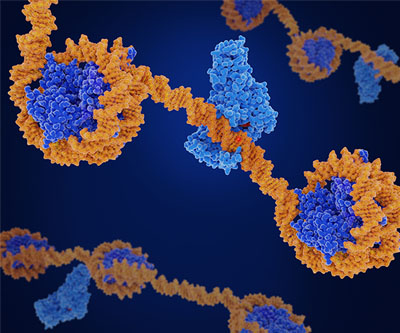
Stock image of DNA (orange) and histones (blue).
During embryonic development, some genes must be silenced or “inactivated” at certain times and places, for instance, in the development of different tissues and organs. This silencing is orchestrated by Polycomb group proteins (PcG), which must be recruited to the gene in question. The genes themselves contain special sequences called Polycomb Response Elements (PREs), which bring in an intermediary—PRE DNA-binding proteins—to recruit the PcGs. One such binding protein is called Pho, and this system is commonly studied in fruit flies as a model organism.
Researchers from the Kassis Lab at NICHD introduced engineered genes, called transgenes, into fruit flies to examine two PREs that were either at the endogenous locus (i.e., where it occurs naturally in the fly’s genome) or inserted via the transgene. The team found that Pho binding sites are required for PRE activity in transgenes with a single PRE. In a transgene, two PREs together led to stronger, more stable gene silencing and conferred some resistance to the loss of Pho binding sites. However, making the same mutation in Pho binding sites had little effect at the endogenous location.
Overall, the data supports a model where Pho is important for PcG binding; however, multiple PREs and the chromatin environment increase the ability of PREs to function in the absence of Pho. Therefore, multiple mechanisms contribute to PcG recruitment, likely providing redundancies that help preserve gene silencing.
NICHD co-authors of the paper include Janet Lesley Brown and Joshua D. Price.
Learn more about the Genetics and Epigenetics of Development Affinity Group: https://www.nichd.nih.gov/about/org/dir/affinity-groups/GED
 BACK TO TOP
BACK TO TOP